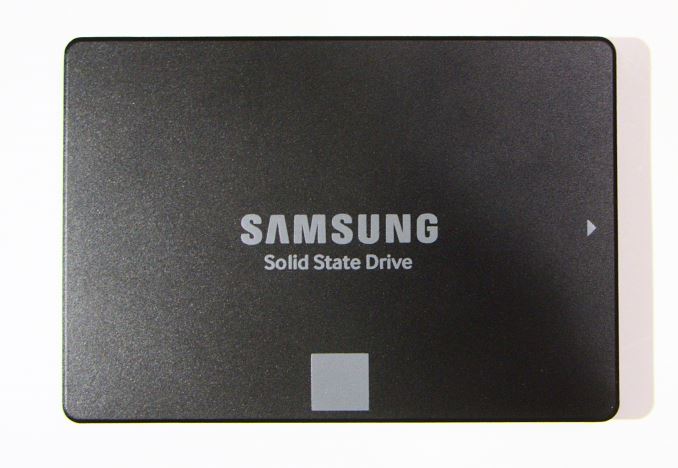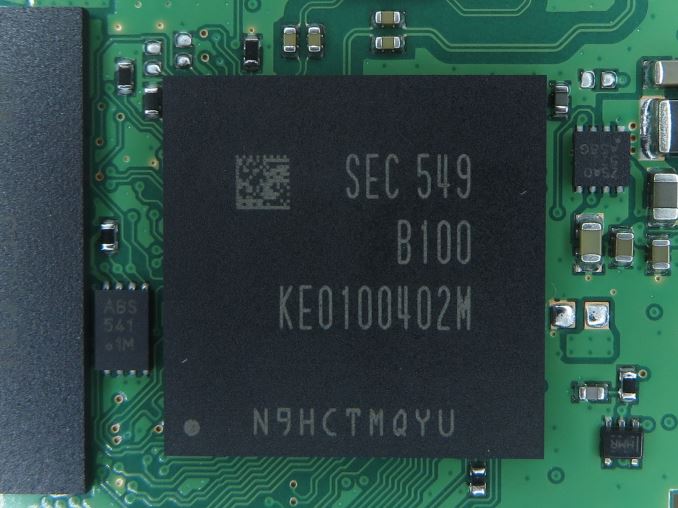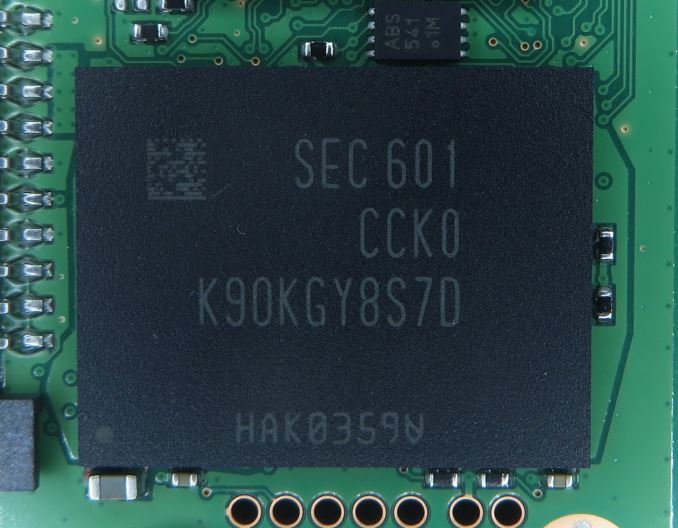The Samsung 750 EVO (120GB & 250GB) SSD Review: A Return To Planar NAND
by Billy Tallis on April 22, 2016 8:00 AM EST
Since the introduction of their first consumer TLC SSD with the SSD 840, Samsung's consumer/retail SATA SSD lineup has consisted of two product families: the MLC-based Pro drives, and the TLC-based 840 and EVO drives. The strength of Samsung's SSD controllers and the advantages of 3D NAND have allowed the 850 EVO to maintain a solidly mid-range position in the SSD market well above any other drive using TLC NAND.
Meanwhile, with the strength of the 850 EVO as a near-midrange product - and with pricing to match - like so many other vendors over the last year, Samsung has also been developing a true low cost TLC drive for the mass market. The end result is the Samsung 750 EVO, which we're revieiwng today. The 750 EVO establishes a new budget-oriented product line that competes in the cutthroat low end of the market where price per GB is the most important aspect of the product.
There are several design choices that help minimize the cost of the 750 EVO, aside from the obvious choice of TLC over MLC. The MGX controller it borrows from the lower capacity 850 EVOs is a dual-core version of Samsung's usual triple-core architecture. Similarly, the 750 EVO is only available in 120GB and 250GB sizes, so there is no high-priced high capacity model. Consequently, with only two small capacities, the 750 EVO line is served by a single tiny PCB layout, made even smaller by the fact that Samsung has put the 256MB of DRAM in the same package as the SSD controller.

Samsung MGX controller with onboard 256MB DRAM
But the most significant aspect of the 750 EVO is that it doesn't use the 3D NAND that has been a key competitive advantage for Samsung's 850 product lines. Samsung has continued development of planar NAND even after transitioning their retail SSDs to 3D NAND, and the 750 EVO in turn uses 16nm planar TLC. It doesn't offer the same performance or endurance of Samsung's 3D NAND, but it does significantly lower the cost of the drive.

128GB of 16nm TLC NAND in a single package
The 16nm TLC NAND is the successor to Samsung's 19nm TLC that had a troubled tenure in the 840 EVO. With the 840 EVO, data at rest on the drive degraded over time and eventually required the use of more thorough and thus slower error correction when read back. As a result the 750 EVO inherits the benefits of all the firmware work Samsung did to mitigate the read speed degradation. This, for what it's worth, gives Samsung some degree of a leg-up against other 16/15nm TLC drives that face the same challenges.
| Samsung TLC SATA SSD Comparison | |||||
| Drive | 750 EVO 120GB | 750 EVO 250GB | 850 EVO 120GB | 850 EVO 250GB | |
| Controller | MGX | MGX | |||
| NAND | Samsung 128Gb 16nm TLC | Samsung 32-layer 128Gbit TLC V-NAND | |||
| DRAM | 256MB | 256MB | 256MB | 512MB | |
| Sequential Read | 540MB/s | 540MB/s | 540MB/s | 540MB/s | |
| Sequential Write | 520MB/s | 520MB/s | 520MB/s | 520MB/s | |
| 4KB Random Read | 94K IOPS | 97K IOPS | 94K IOPS | 97K IOPS | |
| 4KB Random Write | 88K IOPS | 88K IOPS | 88K IOPS | 88K IOPS | |
| 4KB Random Read QD1 | 10K IOPS | 10K IOPS | 10K IOPS | 10K IOPS | |
| 4KB Random Write QD1 | 35K IOPS | 35K IOPS | 40K IOPS | 40K IOPS | |
| DevSleep Power | 6mW | 2mW | |||
| Slumber Power | 50mW | 50mW | |||
| Active Power (Read/Write) | 2.1W / 2.4W (Average) | 2.4W / 2.8W (Average) | Max 3.7W / 4.4W | ||
| Encryption | AES-256, TCG Opal 2.0, IEEE-1667 (eDrive) | AES-256, TCG Opal 2.0, IEEE-1667 (eDrive) | |||
| Endurance | 35TB | 70TB | 75TB | ||
| Warranty | Three years | Five years | |||
By and large the performance specifications for the 750 EVO match the lower capacity 850 EVO, though a slightly lower random write speed at a queue depth of one hints that the 750 EVO may require a bit more background wear leveling work. The feature set is identical to the 850 EVO, making the 750 EVO one of the few low-end drives to support TCG Opal encryption.
Samsung's marketing strategy for the 750 EVO is a little different from their previous retail SSD products. The 750 EVO is targeted specifically at system integrators and system builders, rather than at users looking to upgrade an existing machine. Consequently, they aren't pushing to make the 750 EVO available from as wide a range of retail outlets. Enough of the major online retailers have it in stock that it is not difficult to obtain.
This review will focus on comparing the 750 EVO against Samsung's other SATA SSDs and against other current-generation low-end TLC SSDs of comparable capacity. Our Bench tool can assist in making other comparisons.
| AnandTech 2015 SSD Test System | |
| CPU | Intel Core i7-4770K running at 3.5GHz (Turbo & EIST enabled, C-states disabled) |
| Motherboard | ASUS Z97 Pro (BIOS 2701) |
| Chipset | Intel Z97 |
| Memory | Corsair Vengeance DDR3-1866 2x8GB (9-10-9-27 2T) |
| Graphics | Intel HD Graphics 4600 |
| Desktop Resolution | 1920 x 1200 |
| OS | Windows 8.1 x64 |
- Thanks to Intel for the Core i7-4770K CPU
- Thanks to ASUS for the Z97 Deluxe motherboard
- Thanks to Corsair for the Vengeance 16GB DDR3-1866 DRAM kit, RM750 power supply, Carbide 200R case, and Hydro H60 CPU cooler










109 Comments
View All Comments
lilmoe - Friday, April 22, 2016 - link
Meh. I'll wait until it's half price.haukionkannel - Friday, April 22, 2016 - link
Well, this is 10$ cheaper that 850evo, so this will be very popular among system builders and other with tight budget. Normal upgrade user will definitely go for 850. But this is good enought to most customers.Space Jam - Friday, April 22, 2016 - link
$10 for considerably worse performance does not a winner make.I have a hard time swallowing the cheapo, terrible performance $60 TLC drives. If Sammy thinks anything more than $65 is a good price they have another thing coming.
$60 for a budget 120GB SSD is some audacity.
I and most others will stick to BX100s @ $70 and 850 EVOs @ $75 during the (frequent) sales.
jabber - Friday, April 22, 2016 - link
And if it's upgrading a lot of the older machines desktops and laptops that still only run on SATA II...it doesn't matter. As long as it pushes 285MBps (ish) all day that's all it needs. A lot of kit out there is still SATA II.Alexvrb - Friday, April 22, 2016 - link
Yeah it's got a sequential speed cap. Not all tasks are about peak speeds. I'm pretty sure in terms of IOPS a decent SSD will still beat the snot out of an OEM-grade penny-pinching budget model, even on old SATA 2. Which brings us back to the idea that this is for OEMs and builders - truly this is a "builder-grade" component. If you're upgrading or building for yourself, you'll likely pay a few extra bucks for an 850 Evo or similar unit.With that being said, any of the modern SSDs are better than a mechanical drive. Blech.
leexgx - Wednesday, April 27, 2016 - link
this drive will likely be perfect for the older apple laptops that have that dodgy cable that does not support SATA 3 but the controller does (the cable fails if a high speed cable is used) i had to use a DVD HDD caddy on number of apple laptops due to that issue where it will not detect the SSD or HDDleexgx - Wednesday, April 27, 2016 - link
high speed drive is used (not cable is used) edit be nice on here but that's unlikelyDeath666Angel - Friday, April 22, 2016 - link
I'm guessing the marketing value for "Performance Samsung SSD inside" is considerably higher than comparable Sandisk or Crucial SSDs. And the 10 bucks off compared to the 850 means the margins remain. And if current 1TB laptop drives get replaced by these 250GB 750s, I think everyone is a winner. :DSamus - Monday, April 25, 2016 - link
It's funny you mention that because I would prefer a Sandisk or Crucial/Micron drive over a Samsung anyday.Have you ever tried warranting a Samsung drive? They are hell to deal with. And yes, I still have a sour metallic taste after the 840 Evo debacle that essentially was never fixed.
I also think Crucial/Sandisks Marvell drives, albeit slower, are more consistent, stable and deal with power loss substantially better than the MGX. The fact Samsung is making an SSD with 35TBW endurance in 2016 is pretty damning. I've seen 20GB racked up on old Intel X25-M's in a matter of years so 35GB in a 5 year period isn't out of the question. Just about any other SSD or hard disk for that matter will handle double that no problem at the rated capacity.
vladx - Monday, April 25, 2016 - link
" after the 840 Evo debacle that essentially was never fixed."Don't know what you mean, I also have a 840 EVO and can confirm the performances issues are gone after the 2nd fix.